26.1. – 3.3.17
His Royal Highness and the Brits
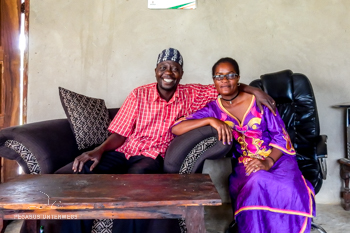
On our way along a very difficult and exhausting earth road we were looking for a place to stay overnight. In the village itself an in front of the school it wasn’t ideal, as we never had less than 100 people watching all our movements. Hence we searched a bit outside the village. But the ground alongside the road was not stable enough. All of a sudden we saw the billboard of the chief’s palace. In Zambia (likewise in other African countries) the chief is a position, which reports nowadays directly to the President and rooted in the history. The chief has some official tasks, such as magistrat, he manages the land allocation in his region – often as big as a Swiss Kanton. On top he has many more local tasks. The chief in this case is a Royal Highness and the people knee down in front of him. So we went to the palace and asked if we could stand in the park for one Night. Lady Carol – the first lady – did allow us to camp there with the back-up of the chief. Of course we had the honour to talk with the chief after dinner. It was interesting and impressive to have a chat with the two of them. A special experience.
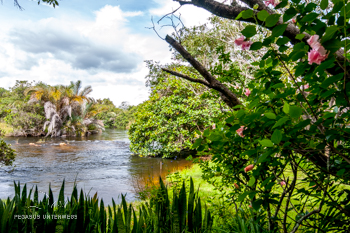
At the hot springs of Kapisha we could camp on the ground of a lodge, which is also a farm. On top they have wonderful hot springs. The owner Mark an Merle offer dinner at their table. That’s the way like Peter knew it from his former journeys to Namibia. This way you pay for your dinner, but you are still guests at their table, which is very likeable and personal. On top Merle is – though born and grown up in Britain – an excellent cook. Everything we ate was produced on their own farm. We’ve decided for the traditional Roastbeef with Yorkshire Pudding. It was absolute fantastic. The after dinner drink in the lounge was the perfect end of a perfect day.
All-wheel-drive Adventure
One of the things we wanted to see were the Kabweluma water falls, known to be really beautiful. The track down there has been described as difficult. And indeed it wasn’t easy, especially as it rained a lot the day before. However Globi mastered that road with some tiny sideward slips. A couple of hundred meters before the junction we had to stop: the bridge over the big river has been flushed away a few weeks ago. No way to go. Driving back with some hundreds of kilometre detour.
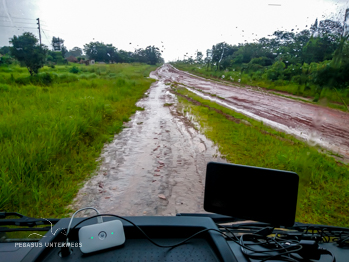
The earth road between Kawambwa and Mwenda is going to be re-constructed, possibly even tared. When we passed this track the sky sent us a really big and heavy tropical rain shower. Sight: approximately 3 meters. The super slippery construction site road is of course slightly bossed so that the water can drain off. So it’s better to stay in the middle of the road. But then, oh no, a huge caterpillar directly in front of us. This time we have to step aside, we are the smaller ones for once. We slide slow down into the drainage channel and start SPULEN, when we try to get back to the road. Luckily at some point the tyres get grip again, thanks to all the diff locks and we are up there. Puuhh, we paused and just waited for the rain to stop. At least the big road construction machines could have helped us, if we hadn’t make it ourselves.
The washed out earth track from Mpepo to Kapisha was critical while driving through the hills. The little drainage bridges had definitely left behind their good days a long time ago. Most likely they rarely had to carry 23 tons. So we were happy when they only gave up while Globis back wheels just left the bridge. Now it was clear: it’s a one way street for us.
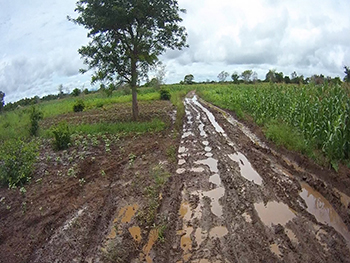
The most adventurous drive was the one from Matumbo to Chama. This somewhat legendary connection was at least “interesting”. Legendary, because we got absolutely varying information from the police, the road agency, the road construction office and the locals about this road, which wasn’t even drawn on our maps. And we wanted to try it in the middle of the rainy season. The first 35km were a perfect, new, hardly used tar road. After that we drove about 60km on a earth track, which was obviously already prepared to be tarred later. Here and there we had pass some sand hills and rubbish, but none of them was a real problem. The little turn-arounds because here and there some water pipes weren’t finished yet we did master as well without any problem. But then the track ended all of a sudden. We were quite tired already so we decided to rest in the middle of the road for the night. The other day we continued giving a lady from the neighbourhood a lift, as people told us she knows the way to Chama. Unfortunately her bladder was even weaker than Peters’ and so she had to do a wee-wee twice. Not really something worth mentioning, if she hadn’t chosen for that places where millions of tsetse flies were around. Every time we had more than 50-60 of them in the driver’s cabin and Gabi had to kill them with a towel. But hey the lady knew the way by heart, so we could easily drive through the bush with the sometimes difficult to find roads. So we made our way nearly up to the new bridge, which nobody really was sure about if it has been built already or not. But before we reached it we became nervous. In front of us we saw a nearly 100 meter long field, which had become very muddy because of the endless rain last night. So 5 kilometre before the bridge we had to take a long ranged decision: try to cross the muddy acre with all its possible consequences if we don’t make it or driving back the 2 days through difficult terrain. We took the forward strategy. Activated all the diff locks, put in the third gear and full speed. Steering wasn’t possible, the bedrock steered us. We made it but unfortunately the acre suffered at the edge. The happiness was endless at the other side of the field, and the fear that the bridge doesn’t exist was even bigger. Then – the bridge was there!
Globi under water
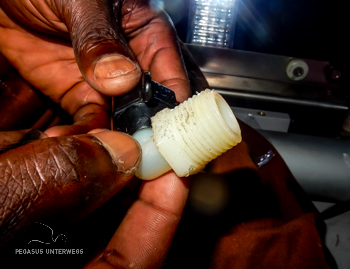
After the heating pump in Botswana we had to deal with the water pump in Zambia. The screw thread of the pipe to the water pump has been damaged when it had been built and with all the vibration it now sprang a leak. Our tool box was under water. As we couldn’t find the correct pieces to repair it we did it the African way: somebody fixed it with a rubber sleeve and funny enough, up to now it works quite well.
As a lot of the roads we drive on are made for Defender we often need to use our wonderful cutting tools. We do that either out of the side windows or from the comfortable roof hatch. One day when we had to drive again through a tropical rain storm we unexpectedly felt like being under a waterfall. Out of the indoor lights it was pouring down directly on our shoulders. Never ever we had thought that an original MAN cabin can be leaky!!! But Globi filled up the lamps. When the rain finished we found out that we had little splints and chips of wood in the rubber seal of the roof hatch, so the water could find its way through the sealing into the lamps.
Now after an intensive cleaning the cabin is dense again.
We also have a nice big roof hatch above our bed. This is super comfortable to let the heat quickly escape after a long hot day. On the other hand water can come in sometimes. And the water sometimes comes very very quickly. We were about 20 seconds too late. The matrasses were wet – whow the Zambian clouds can really pour down! That night we slept on our bathing towels….


Leave A Comment